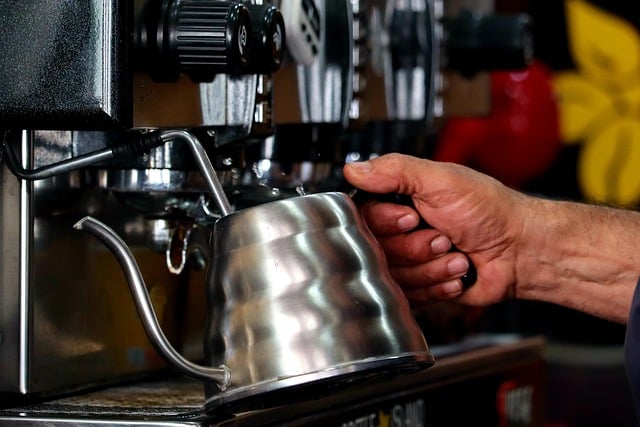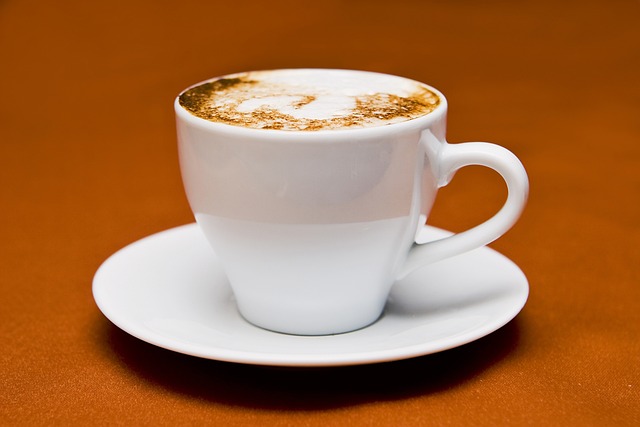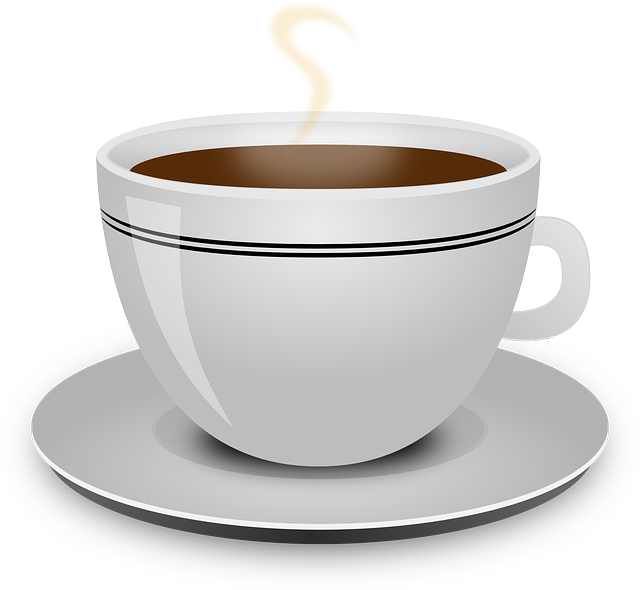Crafting Coffee Excellence: A Home Barista’s Guide to Methods and Recipes
Home brewing coffee allows enthusiasts to explore a wide range of flavors and customize their coffee…….

Home brewing coffee allows enthusiasts to explore a wide range of flavors and customize their coffee experience by choosing from various techniques like the French Press, V60, AeroPress, and espresso machines, each with its distinct taste profile. Factors such as grind size, water temperature, coffee-to-water ratio, and brewing time are essential for creating a balanced cup. Home baristas can experiment with these to achieve flavors from bright and acidic to deep and chocolatey or light and fruity. Espresso machines offer precision in the brewing process, enabling high-quality espresso as a foundation for coffee drinks. The article also explains how to make cold brew and iced coffee, highlighting their different processes and flavor profiles compared to hot-brewed coffee. It encourages both novices and seasoned brewers to master these techniques to enjoy café-quality beverages at home. Pour-over coffee requires careful technique and precise equipment selection; starting with a V60 or Kalita Wave, a medium grind, and maintaining water temperature between 195°F and 205°F is key for a great cup. Cold brew offers a smoother, less acidic taste by soaking coarsely ground beans in cold water for 12 to 24 hours, while iced coffee accelerates the extraction process through rapid cooling over ice, resulting in a more acidic and bitter flavor. Enthusiasts can appreciate the distinct experiences each brewing method provides and discover their taste preference through personal exploration.
Discover the nuanced world of coffee brewing with our comprehensive guide, tailored for home baristas eager to elevate their coffee experience. From the art of pour-over perfection to the rich flavors of French press and the subtle distinctions between cold brew and iced coffee, this article offers a deep dive into mastering brewing techniques. Explore the top 5 coffee recipes that add a twist to your morning routine, from classic lattes to adventurous brews. Understand the science and craft of espresso, and learn how to achieve café-quality coffee from the comfort of your home. Delve into the secret of frothing milk at home for that barista-style finish, and indulge in healthy coffee twists that cater to a conscious lifestyle. With our step-by-step guides and innovative recipes, transform your kitchen into a coffee connoisseur’s haven.
- Brewing Methods and Techniques for Home Baristas
- – Mastering Pour-Over Coffee: Tips and Tricks for the Perfect Cup
- – Cold Brew vs. Iced Coffee: Understanding the Differences and Brewing Guides
Brewing Methods and Techniques for Home Baristas

Embarking on the art of home brewing opens up a world of flavor and creativity for coffee enthusiasts. Mastering various brewing methods allows for a personalized coffee experience, tailored to your individual taste preferences. From the French Press, which offers a rich, full-bodied cup through a simple immersion method, to pour-over techniques like V60 or AeroPress, which provide a more nuanced and precise extraction, each method requires its own technique and timing. The key to achieving a balanced and flavorful coffee lies in understanding the variables that affect the brew: grind size, water temperature, coffee-to-water ratio, and brewing time. Adjusting these elements can transform the taste of your coffee, from bright and acidic to deep and chocolatey or light and fruity.
Furthermore, espresso machines have become increasingly user-friendly, enabling home baristas to craft the perfect shot by controlling variables such as grind fineness, dose, and extraction time. This precision allows for the creation of creamy, aromatic espresso that can be the foundation for a myriad of coffee drinks, from lattes and cappuccinos to more adventurous concoctions. Additionally, cold brew and iced coffee are distinct brewing methods that cater to those who prefer their coffee chilled. Cold brew involves a long, slow extraction process using room temperature water, resulting in a smoother, less acidic beverage with unique flavor profiles. In contrast, iced coffee is typically hot-brewed and then cooled over ice, offering a more traditional coffee taste with a refreshing twist. Whether you’re a seasoned barista or new to the world of home brewing, honing these methods will elevate your coffee crafting skills and bring the café experience into your own kitchen.
– Mastering Pour-Over Coffee: Tips and Tricks for the Perfect Cup

Mastering pour-over coffee involves a delicate balance of technique, timing, and temperature to coax the best flavors from your beans. The process begins with choosing the right equipment; a pour-over brewer such as a V60 or Kalita Wave, along with a medium-grind coffee suitable for this method. Before you start, heat your kettle to just below boiling—typically between 195°F and 205°F (90°C to 96°C)—as water that’s too hot can extract bitter flavors, while water that’s not hot enough may under-extract, leading to a weak, sour cup.
Once your water is heated, grind your coffee right before brewing for the freshest taste. The general coffee-to-water ratio is 1:16 to 1:18 by weight; for example, if you’re using 250 grams of water, aim for approximately 14 to 15 grams of coffee. Place your filter paper in the brewer, rinse it with hot water to eliminate any papery taste and preheat your brewing vessel. Now, gently bloom your coffee by pouring just enough hot water to saturate the grounds, allowing them to ‘open up’ for about 30 seconds before continuing with the rest of the water in a slow, consistent pour over the grounds. This allows for even extraction and helps prevent channels from forming, which can lead to uneven brewing. As the water filters through the coffee, pay attention to the flow rate; it should be steady but not too fast, as this can overwhelm the grounds and lead to over-extraction. The entire brewing process from bloom to completion should take about 3 to 4 minutes. With practice, patience, and attention to detail, you’ll be able to coax out the nuanced flavors of your coffee, resulting in a cup that’s both complex and satisfying. Remember, the key to the perfect pour-over is in the details: grind size, water temperature, timing, and technique all play critical roles in achieving brewing perfection.
– Cold Brew vs. Iced Coffee: Understanding the Differences and Brewing Guides

Cold brew and iced coffee are two distinct methods to enjoy coffee, each offering a unique taste experience. Cold brew is a coffee extract made by steeping coarsely ground beans in room temperature or cold water for an extended period, typically between 12 and 24 hours. This slow extraction process results in a beverage with lower acidity levels than traditionally brewed hot coffee, yielding a smoother, sweeter flavor profile with subtle nuances of the coffee’s origin. The long steeping time extracts less of the bitter compounds found in coffee, making it an excellent choice for those sensitive to acidity. To make cold brew at home, use a 1:4 coffee-to-water ratio, and a large container or a dedicated cold brew system to minimize agitation during the steeping process, which can introduce bitterness.
Iced coffee, on the other hand, is hot-brewed and then cooled over ice. This method involves brewing with hot water as you would for a regular pot of coffee, but the resulting liquid is poured over ice to enjoy immediately. The quick extraction from the hot water brings out more of the coffee’s acidity and can highlight its brightness and bitterness. To prepare iced coffee at home, simply brew your coffee as usual and pour it over ice once it has finished brewing. While both cold brew and iced coffee can be refreshing on a warm day, their different brewing methods result in distinct flavor profiles that coffee enthusiasts can appreciate. Experimenting with these two methods allows you to explore the diverse possibilities within the world of coffee and find your personal preference.
Whether you’re a seasoned home barista or just beginning to explore the world of coffee brewing, this guide has equipped you with the knowledge and skills to master a variety of techniques and recipes. From the nuanced art of the French Press to the precision required for a perfect espresso shot, and from classic lattes to innovative coffee creations, there’s something here for every palate and preference. Understanding the distinctions between cold brew and iced coffee, as well as learning how to make both, ensures you can savor the right beverage at the right temperature any time of year. Additionally, the healthy alternatives provided offer a guilt-free way to indulge in your coffee ritual. With these tips and techniques under your belt, you’re now well-equipped to elevate your home coffee experience and craft café-quality drinks with confidence. Happy brewing!







